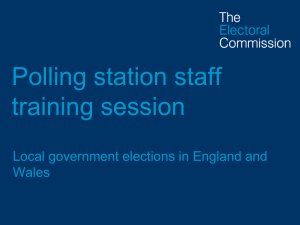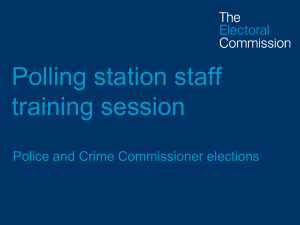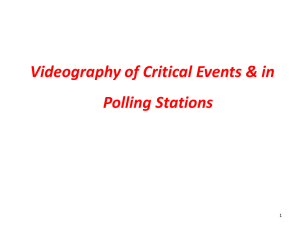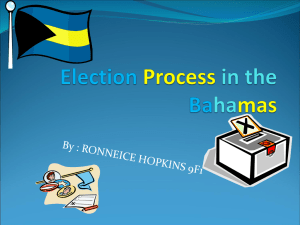EPE-Briefing for polling station staff
advertisement
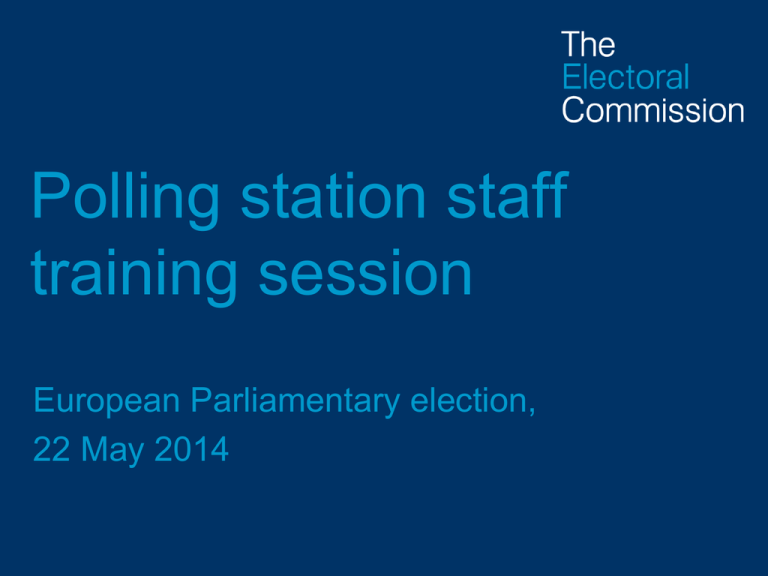
Polling station staff training session European Parliamentary election, 22 May 2014 Introduction Local Returning Officer Electoral Services Manager Objectives of the training session • Your role is vital in ensuring that voters have confidence in the election process • At this session we will: – outline what we expect you to do on polling day – discuss the voting procedures – think about health and safety issues – highlight a number of administrative arrangements Key aims for the election • that all voters have a good experience, with any person who is entitled to vote being able to do so • that the poll is professionally delivered • that we produce accurate results in which all stakeholders are confident • that the process is transparent • that the poll is consistently administered It is essential that you… – act impartially at all times – comply with any instructions issued by the local Returning Officer – ensure the secrecy and security of the ballot • Liaise with the key-holder of the building • Organise the layout of the polling management of station the polling • Instruct and supervise the work of station the Poll Clerks • Account for all the ballot papers, ballot boxes and paperwork The Presiding Officer – The Poll Clerk – general duties • • • • Assist with the layout of the polling station and prepare for the opening of the poll Be polite and professional in dealing with the voters Check that electors are eligible to vote at that polling station Understand the process for issuing ballot papers Countdown to polling day • Essential tasks – Visit polling place and check out contact and access arrangements – Check out arrangements for ballot box collection and check contents as soon as possible – Contact other members of the team – Dress code – ensure clothing reflects professionalism and impartiality but is also comfortable and suitable for the weather conditions. Polling station inspectors • A point of contact • Supplies of stationery and equipment • Responsible for carrying out polling station checks • Contact numbers [ ……………. ] Risks • • • • • • Can’t make contact with key-holder Can’t gain access to the polling station Staff failing to turn up or being late Problems displaying notices Wrong registers allocated to the station The ballot paper numbers do not match those pre-printed on the CNL • Tendered ballot papers wrongly issued • Queues building up throughout polling day • Bad weather, flooding The Polling Station Setting up, layout and who can enter the polling station Setting up the polling station • Layout / notices (see set-up checklist in Appendix 12 of the Polling station handbook) – – – – – must work for the voter walk route voter expected to follow check all notices up and pencils ready and sharp properly accessible to voters consider needs of wheelchair users (e.g. doors, space to manoeuvre, vote in secret) – provide seats for electors who may need to rest – voting in secret (booths not overlooked by windows) • Prepare the stationery – arrange the ballot papers in numerical order – prepare register and corresponding number list – keep tendered ballot papers in packet Setting up the polling station (cont) • Polling agents, tellers and others – consider where polling agents, tellers, other supporters/campaigners can / can’t be • Location of ballot box(es) – accessible and secure • Sealing the box(es) – show box is empty – seal as advised just before 7am – don’t allow candidates / agents to add seal at this time Polling station layout Polling station layout Who can enter the polling station? – Voters – Regional Returning Officer, local Returning Officer and staff – Candidates and election agents – Polling agents – Police officers and community support officers on duty at the polling station – Representatives of the Electoral Commission – Accredited observers – Under 18s accompanying voters – Companions of voters with disabilities Accredited observers and Commission representatives Customer care • Show a personal interest • Be helpful and approachable • Listen and empathise with them • Allow them to put their point across before responding • Don’t say ‘No’, tell them what you can do for them and what they can do • But the election rules must be followed at all times, no matter how insistent, upset or angry they are • If in doubt, contact the elections office Customer care • Ensure that the voting process is accessible to all: (cont’d) – layout must work for all voters, including wheelchair users – stationery provided in alternative languages and formats should be clearly visible – you must be able to provide information to disabled electors on options for voting Tactile voting • Tactile template needs to be clearly visible and you should be confident in using it template • How to use - make sure that the template is securely attached to the ballot paper and that the voter is confident about using it. The voter should: - lift the selected window in the voting choice column - mark their choice of candidate or party with a cross (X) - close the window - separate the template from the ballot paper - fold and place the ballot paper in the ballot box - return the template to the Presiding Officer Who can and cannot vote? Using the electoral register and corresponding number list Who is eligible to vote at the polling station in the European Parliamentary election? • Electors with no letters or dates before their name • Electors who are 18 years of age or over on the day of the election • Electors with an ‘F’ before their name • Electors with a ‘K’ before their name • Electors with an ‘L’ before their name • Electors with an ‘E’ before their name • Electors who have registered anonymously who have an ‘N’ instead of a name • [In Scotland only] Electors with a ‘U’ before their name • Who cannot vote at the polling station • in the European Parliamentary • election? Electors with date of birth on register which shows they are not 18 years of age on polling day Electors with a ‘G’ before their name Electors with an ‘A’ before their name • Marking the register and the CNL Issuing the – Ask the elector to confirm their name and ballot papers address – Mark electors’ elector number in the register – Call out the name and elector number of the elector – Enter the elector number on the Corresponding Number List (CNL) – Do NOT write the elector number on the ballot paper! Issuing the ballot papers (cont) • Ballot papers – Open up fully so the whole paper is visible – Official mark, Ballot paper number and unique Identifying Mark (UIM) Marking the register Queen’s Walk BC JP32 4LT 411 G 412 F 413 K 414 415 416 417 418 A 418/1 Vella, Eva Jolly, Simon Vella, Christina Brown, Robert Evans, Gareth Singh, Parvinder Millar, Beth Juba, Charlotte 22 May 2014 Watts, Judith 1 1 1 3 5 7 7 15 15 Example Corresponding Number List (CNL) BC 27/1 Exceptions to the rule • Anonymous electors – – – – Must have poll card Marked ‘N’ on register Name and address must not be called out Mark the register by their poll number as usual • Other electors – At end of register (end of split station) • Clerical errors – On separate register sheet • Always check if cant find on register Example reverse of ballot paper • Some electors may need to have the voting Marking the process explained to them: ballot paper – Voters have one vote. They can vote for a party (and its list of candidates) or for an individual candidate and should place a cross in the blank box next to the party or individual candidate they wish to vote for. What happens if…? • you are handed a certificate of employment • a voter spoils a ballot paper • a voter has nominated a proxy but the voter arrives before the proxy • a person arrives to vote but the register indicates the person has already voted • a person arrives to vote but the register indicates the person is a postal voter • a person arrives wanting to vote as an emergency proxy • a person believes they should be on the register but they are not listed • there is a disturbance at the polling station The prescribed questions • The prescribed questions must be asked: – when a candidate, an election agent (or subagent attending on the election agent’s behalf) or polling agent requests them – before issuing a tendered ballot paper • The prescribed questions should be asked: – when you suspect personation – when a registered elector is clearly under age – when an elector states their name is not as shown in the register of electors • No other enquiry or questioning of electors is allowed Postal votes • voters can hand in their postal votes at any polling station in the counting area (local authority area) • returned postal ballot packs must be stored, sealed and labelled as instructed • postal votes will be collected during the day, with the remainder returned with the ballot box at close of poll Postal votes • ‘A’ markers cannot be given an ordinary ballot paper at the polling station: – direct to local Returning Officer for replacement (before 5pm) – tendered ballot paper procedure after 5pm • exception: where an elector claims never to have applied for a postal vote. In such a case, they would be eligible for a tendered ballot paper at any time. However these electors should be encouraged to apply for a replacement at the elections office if before 5pm. Close of Poll The procedures to be followed Managing a • At any point in the day – call the election office queue • Just before 10pm – make sure those waiting can cast their vote – check that anyone waiting to vote is at the correct polling station for their address Managing a • At 10pm: – bring all the waiting electors into the queue (2) room/building and close the door, OR – if the room/building is not big enough, a member of the team should stand at the end of the queue to mark it – continue to issue ballot papers until everyone who was in the queue by 10pm has voted • Anyone who was not in the queue at 10pm must NOT be issued with a ballot paper. Close of poll • Once the last voter has voted, seal the ballot box • Candidates/agents are also entitled to affix seals to the ballot box at this point After close of poll • Absolutely essential that the ballot paper account is completed accurately • The ballot paper account must be placed in the envelope provided – keep these with the ballot box(es) • Ensure all documents placed in correct packets and signed as appropriate • Poll clerks to assist packing up station to allow presiding officer to do these important tasks Health and safety • never put the safety of anyone inside the polling station at risk • be aware of any potential risks to safety • inspect the premises regularly • if hazards are discovered – find a remedy • if an accident occurs – follow procedures • be careful when lifting heavy objects Any questions? Additional Information • Election team contacts • Electoral Commission website – www.electoralcommission.org.uk – www.aboutmyvote.co.uk • Feedback Sheets
